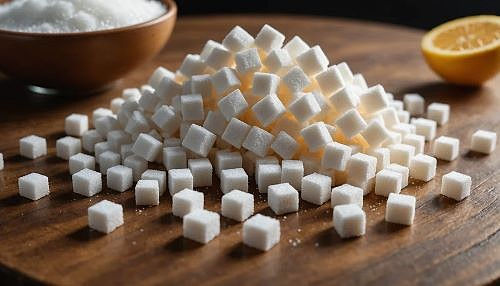Glucose in Nature: Ecology & Environment
- Sylvia Rose

- Feb 8
- 5 min read
Glucose is a carbohydrate, a simple sugar or monosaccharide. It fuels life and ecology. Made by plants, glucose empowers microorganisms and is the basis of agriculture, nature and the environment.

Glucose has the chemical formula C6H12O6, indicating six carbon (C) atoms, twelve hydrogen (H) atoms and six oxygen (O) atoms. It's a primary energy source for all living organisms.
Made from sunlight, glucose is created during photosynthesis of plants. In this process, green plants and some bacteria convert sunlight, carbon dioxide, and water into glucose and oxygen.

This vitalizes plant growth and establishes the foundation of the food chain. In agriculture, an acre of corn can produce approximately 27,000 pounds of glucose through photosynthesis in a growing season.
Glucose is also generated through breakdown or reduction of complex carbohydrates like starch and cellulose. This process is part of nutrient cycling and decomposition in the environment.

Glucose has many environmental functions.
Energy Source
Glucose is a readily available source of energy for almost all living organisms. Through cellular respiration, glucose is reduced to release energy in the form of ATP (adenosine triphosphate). ATP fuels processes from growth and reproduction to movement and internal functions.
Structure
Glucose can be combined into larger, more complex carbohydrates like starch, cellulose and chitin. These polysaccharides provide structural support and energy storage for plants, fungi and animals.

Plants convert excess glucose into starch, an energy reserve. It's used especially during low photosynthetic periods.
Biosynthesis
Glucose is a precursor for synthesizing amino acids, fatty acids, and nucleotides. It's vital for cell metabolism and growth. Plants use up to 70% of glucose produced in photosynthesis for growth and maintenance.
Microbial Activity
Soil microorganisms rely on glucose for energy, which promotes nutrient cycling and soil fertility. A gram of healthy soil can contain up to 1 billion microbes, all using glucose to break down organic matter. At unseen levels the earth is continuously moving and breathing.

Carbon Cycling
Glucose is a key component of the carbon cycle. Photosynthesis removes CO2 from the atmosphere, storing it as glucose in plant biomass. Plants continuously interact with the atmosphere by exchanging carbon.
During photosynthesis, plants take in carbon dioxide. Most carbon dioxide is stored in roots, permafrost, grasslands and forests. As plants and soil decompose, they release carbon dioxide back into the atmosphere. Ideally it's consumed by other plants and converted to oxygen.

Soil Health
Glucose and its derivatives contribute to soil structure and fertility. Microorganisms use glucose as an energy source. They produce nutrients contributing to humus formation, improved water retention and aeration.
Practices like crop rotation and cover cropping increase organic matter in soil, promoting microbial activity and glucose production. This can improve soil structure and nutrient availability.
Too much is too bad. Excess glucose runoff from agricultural fields contributes to nutrient pollution in waterways, harmful algal blooms and oxygen depletion.

Plant Development
Plants use glucose not only as a direct energy source but also as a precursor to other essential molecules like amino acids, lipids, and nucleic acids, all vital for growth and development.
Glucose levels improve plant defenses against pests and diseases. The concentration of glucose in a plant's sap can indicate its health and nutritional status.

Agriculture
Glucose forms in tissues of plants such as fruit, vegetables, and grain. It contributes to the nutritional value and palatability of crops. Nutrient management in fertilizers helps optimize glucose synthesis in plants.
Some plants, called "C4 plants" based on methods of carbon fixation, have adapted to use glucose more efficiently. They can prosper at high temperatures, contributing to increased photosynthetic rates. C4 plants include maize, sorghum and sugar cane.

Glucose and the Microscopic World
Yeast and Fermentation
Yeast, like Saccharomyces cerevisiae, uses glucose in the process of fermentation to produce ethanol and carbon dioxide. This process is used for brewing beer, baking bread, and producing biofuels. 1 kg of glucose makes about 0.5 L of ethanol.
Bacteria and Decomposition
Bacteria are essential to decompose organic matter. The enzymes they secrete reduce complex carbohydrates to glucose, which is used as an energy source.
Some bacteria can produce glucose from CO2 even in the absence of sunlight. They use chemical energy in the process of chemosynthesis.

Microbial Products
Many microorganisms create products from glucose, including antibiotics, organic acids (like citric acid and lactic acid), and bioplastics. These are used in medicine, food processing and the ever-growing industry of environmental remediation due to pollution caused by growth of industry.
Lactic Acid Bacteria
Some bacteria ferment glucose to create lactic acid, prevalent in food preservation and flavor enhancement. A cup of yogurt contains about 12 grams of glucose, made with the fermentation process.
Decomposers
Bacteria and fungi decompose organic materials, releasing glucose and other carbon compounds back into the soil. This process enriches the soil and promotes plant health, with decomposers contributing to over 50% of soil organic matter.

Non-Fiction Books:
Fiction Books:
READ: Lora Ley Adventures - Germanic Mythology Fiction Series
READ: Reiker For Hire - Victorian Detective Murder Mysteries


